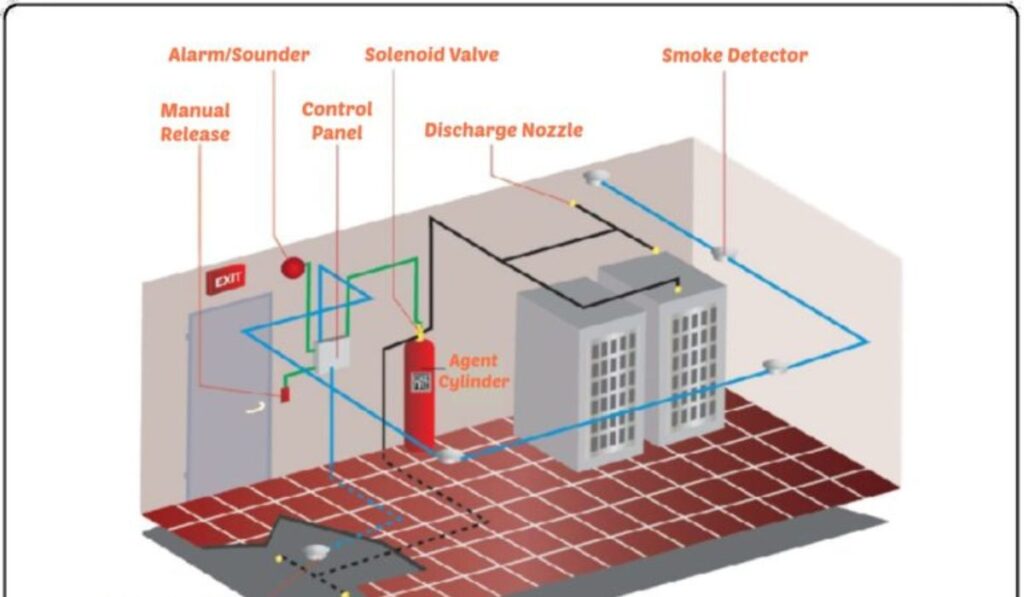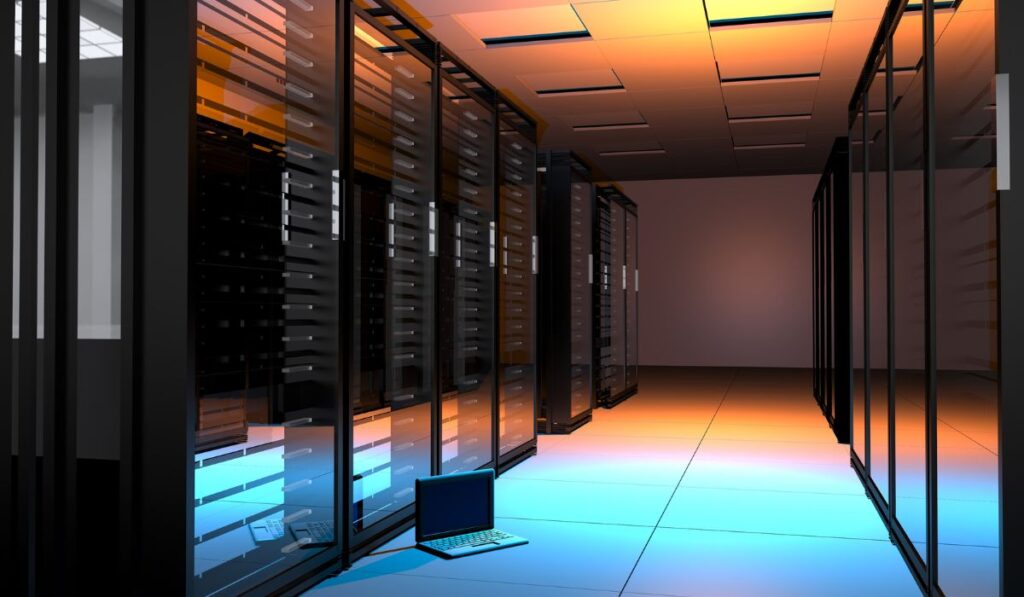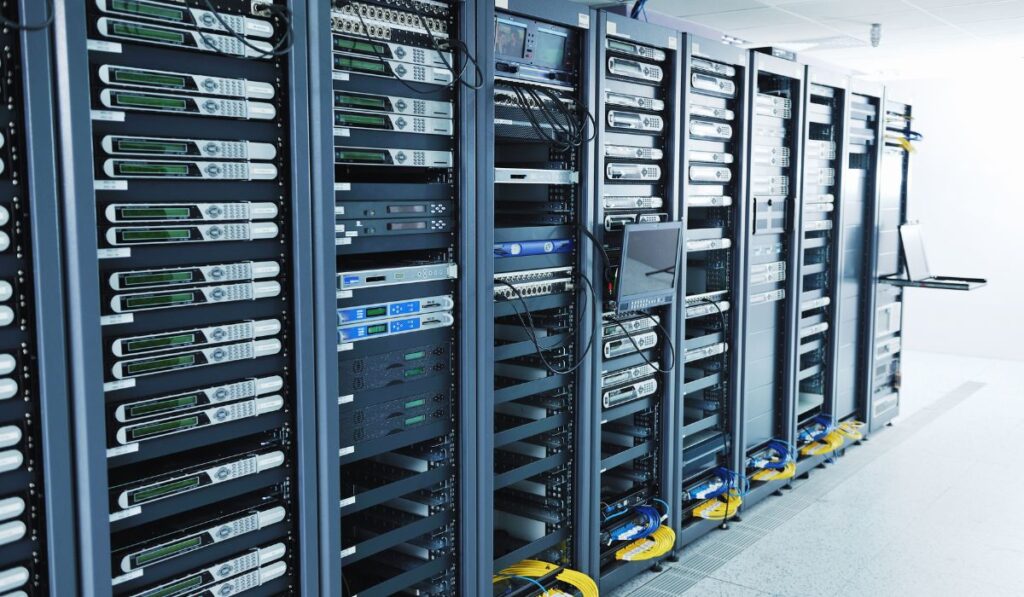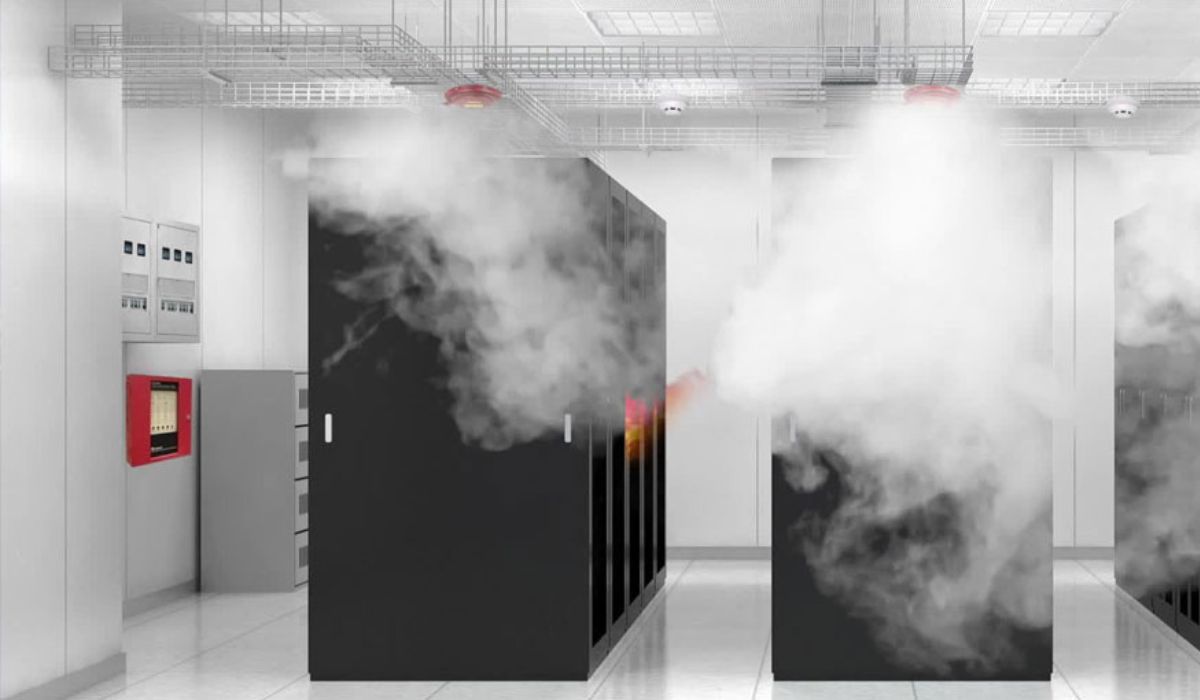Server room fire suppression systems protect critical IT infrastructure from fire damage. They quickly extinguish fires without harming equipment or data.
Server rooms are vital hubs for businesses, housing the servers that store and process crucial data. Ensuring the protection of these rooms against fire hazards is imperative to maintain business continuity and to protect significant investments in technology. Traditional water-based sprinkler systems can be as damaging as fire to sensitive electronic equipment, which is why server rooms typically employ gas or clean agent fire suppression systems.
These systems detect fires early and suppress them swiftly with minimal impact on the hardware. They often use environmentally friendly agents that leave no residue, thus negating the need for cumbersome cleanup and allowing for quick recovery of operations. Keeping a server room operational during and after unexpected events is key to the resilience of any data-dependent business.

The Hidden Dangers In Server Rooms
The heart of any modern business often beats within its server room. These vital spaces, brimming with technology, also harbor risks not immediately apparent to the untrained eye.
Potential Fire Hazards
A server room’s environment can conceal various hazards. Let’s uncover some:
- Electrical Overload: The excessive use of power strips.
- Circuit Failures: Aging infrastructure could lead to sparks.
- Overheating Equipment: Devices that run 24/7 emit significant heat.
- Flammable Materials: Items like cardboard boxes increase fire risk.
These hazards, often ignored, require serious attention to prevent a blaze.
Consequences Of Server Room Fires
Consequences of a server room fire can be dire. Let’s examine the impacts:
| Impact | Description |
|---|---|
| Data Loss | The irreversible loss of critical business information. |
| Equipment Damage | The complete ruin of costly servers and networking devices. |
| Downtime | A halt in business operations, leading to financial losses. |
| Health Risks | Potential harm to personnel due to smoke inhalation or accidents. |
Preventive measures and a reliable fire suppression system become indispensable.
Fire Suppression Needs For It Environments

Server rooms are the heart of IT operations. They demand fire suppression systems that protect without damaging sensitive equipment. Understanding server room fire suppression needs is critical for any organization that relies on technology.
Special Considerations
IT environments need unique fire protection. Unlike traditional fire suppression systems, those designed for server rooms must tackle flames without harming electronics. Here are key points to consider:
- Use of clean agents: Chemicals that leave no residue and won’t damage hardware.
- Sensitive detection: Systems that quickly detect smoke or heat before flames grow.
- Minimal downtime: Suppression methods that allow for swift recovery and continuation of operations.
Complying With Fire Safety Codes
To ensure safety, server rooms must follow strict fire codes. Regular audits and adherence to guidelines keep your IT assets safe. Key compliance areas include:
| Area | Requirement |
|---|---|
| Local codes | Understand and implement local fire safety regulations. |
| Agent selection | Choose suppression agents approved by recognized standards. |
| Installation | Engage qualified professionals for system setup. |
Comparing Fire Suppression Systems
The right fire suppression system could save a server room from disaster. Businesses must understand their options to make informed decisions. In this section, we compare different fire suppression systems to aid in selecting the best solution for server rooms.
Water-based Vs. Gas-based Solutions
Water-based systems, like sprinklers, are common in many facilities. They rely on water to extinguish fires, which can be effective but may pose risks to electronic equipment. On the other hand, gas-based fire suppression uses inert gases or chemical agents. They extinguish fires without damaging sensitive electronic devices.
| System Type | Advantages | Disadvantages |
|---|---|---|
| Water-Based |
|
|
| Gas-Based |
|
|
Pros And Cons Of Emerging Technologies
Emerging technologies in fire suppression bring innovative solutions to server rooms. These include sound wave fire suppression and automated mist systems. Each comes with its unique benefits and challenges.
| Technology | Pros | Cons |
|---|---|---|
| Sound Wave Suppression |
|
|
| Automated Mist Systems |
|
|
Key Components Of Effective Fire Suppression

Imagine a fortress; robust, ready to protect its treasure. Now, think of server rooms as digital fortresses, guarding data, the modern world’s treasure. Effective fire suppression is a critical shield for these bastions of bytes. It involves keen detection and swift action to snuff out threats, safeguarding technology and data from the ravages of fire.
Let’s break down the core elements that make server room fire suppression systems truly effective.
Detection Systems
Alert and responsive, detection systems are the watchful eyes in the server room, always scanning for the first hint of smoke or heat. Here’s what they do:
- Smoke detectors catch the earliest signs of a fire.
- Heat sensors monitor unusual temperature spikes.
- Manual pull stations provide human control.
Together, these elements ensure that a fire is detected swiftly, kicking the suppression process into gear without delay.
Suppression Agents
Once a fire is spotted, suppression agents spring into action. They are the heroes that fight the flames. There are various agents used:
- Clean agents: Leave no residue and protect delicate equipment.
- Carbon dioxide: A non-conductive, non-corrosive gas, smothers the fire.
- Water mist: Reduced damage compared to traditional water sprinklers.
Each agent serves a purpose, with some focusing on quick fire knockdown while others prioritize protecting equipment. The choice hinges on balancing fire fighting efficacy with equipment safety.
Installation Best Practices
The safety of server rooms from fires is critical for any business. Here we’ll explore Installation Best Practices to ensure your server room has the best fire suppression system.
Planning And Design
Thoughtful planning is the cornerstone of effective fire suppression in server rooms. Start with these steps:
- Assess risks: Consider server load, electrical setup, and room layout.
- Choose appropriate technology: Decide between options like FM200, NOVEC 1230, or Inergen systems based on your needs.
- Calculate space: Determine the volume of the area to select the right system size.
- Allow for scalability: Make sure the system can grow with your server room’s needs.
- Ensure compliance: Adhere to NFPA and local fire codes.
Professional Installation
Installing a fire suppression system requires expert knowledge. Follow best practices:
- Choose certified professionals: Your system’s efficacy depends on a correct installation.
- Prevent obstructions: Sensors and nozzles must remain unblocked.
- Conduct thorough testing: Test the system to confirm it works properly.
- Train staff: Ensure that your team knows how the system operates.
- Schedule regular maintenance: Keep your suppression system in top condition with routine checks.
Routine Maintenance And Inspection
Keeping your server room safe from fire hazards means sticking to a strict routine of maintenance and inspection. This crucial practice ensures your fire suppression system is ready at a moment’s notice. Protect your vital tech assets and data by implementing a regular schedule and detailed checklist.
Maintenance Schedule
Establishing a regular maintenance schedule is paramount. Specific tasks need completion at different intervals:
- Monthly: Check system indicators and gauges.
- Quarterly: Examine batteries and connections.
- Semi-Annually: Test system actuators and sensors.
- Annually: Full system inspection and certifications by professionals.
Staying on track with these intervals prevents unexpected system failures.
Inspection Checklist
A thorough inspection checklist can catch issues before they escalate. Include these points on your list:
| Checklist Item | Importance | Status |
|---|---|---|
| Nozzle obstruction | High | Check for clear path |
| Agent levels | High | Verify sufficient suppressant |
| Power supplies | Medium | Test for consistent delivery |
| Control panel | High | Ensure error-free operation |
Document any irregularities immediately and address them promptly.
Emergency Response Plans
The protection of server rooms against fire hazards hinges on not only the right equipment but also on robust Emergency Response Plans. These plans set the stage for swift, effective actions in crisis situations. A comprehensive plan minimizes damage and protects both staff and critical data infrastructure.
Developing A Server Room Fire Action Plan
To keep a server room safe, you must craft a Fire Action Plan. This blueprint outlines the specific steps to take during a fire. It ensures everyone knows their roles and the procedures to follow.
- Assess Risks: Identify potential fire sources and high-risk areas.
- Equip Accordingly: Install suitable fire suppression systems.
- Communicate Routes: Clearly mark escape routes for quick evacuation.
- Designate Leaders: Assign fire safety roles to selected staff members.
- Document Plan: Keep copies of the plan accessible to all staff.
Training Staff For Emergencies
Training transforms plans into action. It ensures staff react quickly and effectively, bringing a situation under control. Organized, regular training sessions are vital.
- Initiate Drills: Conduct regular fire drills to reinforce evacuation procedures.
- Fire Safety Education: Teach staff about fire risks and the use of fire extinguishers.
- Role-specific Training: Provide specialized training for designated fire safety roles.
- Update Regularly: Refresh training to address new threats and safety protocols.
Real-life Incidents And Learnings
Fires in server rooms can spell disaster for any business. They can cause irreversible data loss and costly downtime. Learning from real-life incidents is crucial to enhance fire safety and ensure business continuity. This section covers some of the most striking examples and the improvements made in response to these fires.
Case Studies
Real incidents offer invaluable insights into the risks and responses associated with server room fires. We look at a few noteworthy cases where fire suppression played a vital role.
- Major Telecom Company: A fire triggered by electrical failure led to service outages. The room’s suppression system contained the fire, preventing a total loss.
- Cloud Service Provider: Overheated servers caused a small fire, quickly extinguished by the building’s sophisticated suppression system, averting a major catastrophe.
- Financial Data Center: A malfunction in the cooling system resulted in a fire, which was subdued by a clean agent fire system, protecting critical data.
Improvements In Fire Safety
Following these fires, significant safety improvements took place. Let’s examine some enhancements made to protect server rooms better.
- Installation of more advanced smoke detectors, providing an early warning and faster response time.
- The use of clean agent fire suppressants that don’t damage electronic equipment has become more prevalent.
- Regular maintenance checks are now routine to avoid electrical malfunctions that can lead to fires.
- Training staff in fire safety protocols ensures that everyone knows how to act in a fire emergency.
The Future Of Fire Safety In Data Centers
Imagine a world where data centers operate with unparalleled safety. The future of fire safety in data centers lays the foundation for such a reality. Enhanced protection against fires not only safeguards our precious data but also ensures business continuity and personnel safety. As we delve into this topic, we’re met with emerging innovations and regulatory measures set to transform fire safety within these critical facilities.
Innovations On The Horizon
Data centers are vital for storing large amounts of digital information. Protecting them from fire is crucial. Exciting technologies are now in development to enhance fire suppression. These include:
- Air-sampling devices that detect fires early.
- Sound wave fire suppression that extinguishes flames without water or chemicals.
- Robotics for automated fire response in hazardous environments.
- Eco-friendly suppression agents that protect equipment and the environment.
These innovations aim to detect fires quickly, put them out efficiently, and reduce harm to the environment.
The Role Of Regulation And Standards
Regulations are essential for keeping data centers safe. They make sure that buildings follow strict rules to prevent and control fires. The future holds:
- Global standards that create uniform fire safety protocols across borders.
- Regular updates to building codes to include the latest in fire suppression technology.
- Strict certification for fire safety equipment to ensure reliability.
- Training programs for staff to handle fire incidents effectively.
With these steps, we can expect a safer future for data centers around the world.
Frequently Asked Questions On Server Room Fire Suppression
What Type Of Fire Suppression Is Used In Server Rooms?
Server rooms often use clean agent fire suppression systems, like FM-200 or NOVEC 1230, due to their non-conductive and non-damaging properties to electronics.
What Are The Fire Protection Requirements For A Server Room?
Server room fire protection requires early detection systems, such as VESDA, automatic fire suppression like FM200 or NOVEC 1230, clear evacuation plans, regular maintenance checks, and compliance with local fire safety codes.
Should A Server Room Have A Fire Extinguisher?
Yes, a server room should have a fire extinguisher that is suitable for electrical fires, commonly a Class C extinguisher in the U. S. , or a CO2 or FM-200 extinguishing system.
How Do You Put Out A Fire In A Server Room?
To extinguish a fire in a server room, firstly activate the fire suppression system. Then evacuate the area immediately, and call emergency services. Never use water; instead, rely on gas or clean agent extinguishers designed for electrical fires. Always follow your company’s safety protocol.
Conclusion
Securing your server room from fire hazards is paramount. Implementing appropriate fire suppression solutions safeguards vital data and hardware. Prioritize regular maintenance and upgrades for optimal protection. Remember, investing in reliable fire suppression is investing in your business’s continuity and security.
Stay safe, stay secure.

I’m Abdus Sobur, a highly skilled and professional Fire Safety Officer with a passion for safeguarding lives and property. Over the course of my career, I’ve conducted numerous successful fire safety audits, earning a reputation for excellence in ensuring public safety.
In addition to my role as a Fire Safety Officer, I’m also dedicated to raising awareness about the importance of fire safety. Through my blog, I share insights into the functions of different fire safety equipment, aiming to empower individuals with the knowledge they need to protect themselves and their communities.
I’m driven by a deep commitment to promoting fire safety awareness and preventing fire-related incidents.

